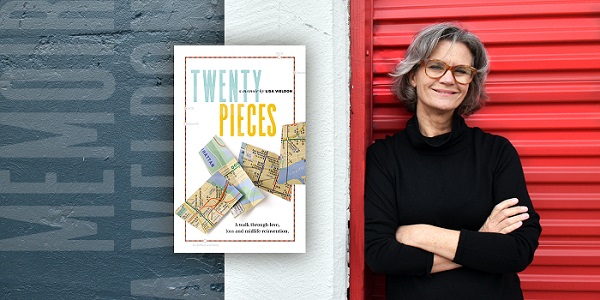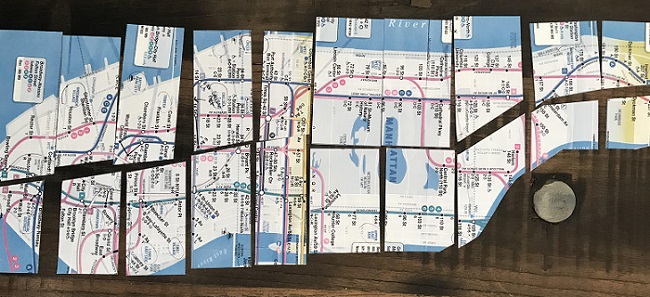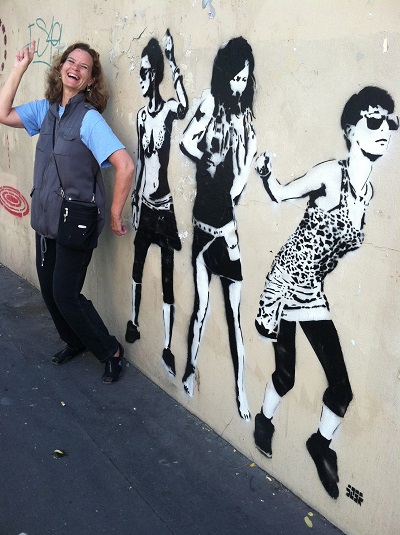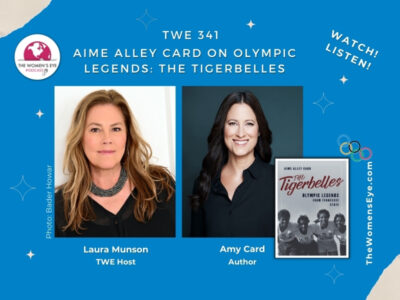
What if you found yourself facing a flagging career, a broken marriage, and a pile of financial woes? That could happen to anybody but it happened in spades to Lisa Weldon, an award-winning Creative Strategist in the advertising business. Facing almost insurmountable problems, she came up with a creative and challenging solution.
“I took an X-Acto knife and sliced a map of Manhattan into 20 pieces. The plan was to pick one piece per day, walk that piece and blog about it…I was going, but not sure how I was going to pull it off. I wasn’t sure the check I wrote for the deposit was going to clear. That’s how bad off we were.” Lisa Weldon
In her unvarnished memoir, Twenty Pieces: A Walk Through Love, Loss and Midlife Reinvention, Lisa chronicles how she handled an economic turndown, a failing business, three kids at various stages of leaving home and even a home foreclosure. I wanted to find out how her life’s pivot at 58 years old became a compelling story about more than just the job…
EYE: You left your life in Atlanta in the midst of huge personal and professional issues. Why such a bold move?

LISA WELDON: Among other things, I needed to upgrade my skillset. Being in advertising, I’ve always loved New York. Working on Madison Avenue was my dream. Every November since I was in my twenties, I got the Parsons School of Design catalog that listed 30-day intensive summer courses for professionals such as me. I’d flip through it; my heart would just beat. I’d look at it for about a month and finally throw it away.
On New Year’s Eve, December, 2010, I sent my family off to a party, which I normally went to. I sat in my office and I dug out that catalog from the trash.
I looked at the courses I circled, that I dreamed about taking, went to the kitchen, poured myself a glass of wine and said, You know what? Dammit, I’ve got to start earning some big money, you know, I mean, we’re losing it here. I was going but not sure how I was going to pull it off.
EYE: How did you prepare or even afford the trip?
LISA: I spent the next three or four months preparing savings plans; trying to find an affordable Airbnb; looking at NYU dorm rooms. I didn’t even have an iPhone. I was doing video classes at night trying to learn the basic language so that when I arrived in New York, I wouldn’t be totally green.
It got down to the point where I was going to have to send another check for the full balance. I was going to have to pay for a place to stay and the numbers just weren’t adding up. A month or so before I was supposed to get on that airplane, my husband walked in and said the house was going into foreclosure.
Then ten days before I was supposed to leave, Parsons called and said the class was cancelled. That was my out and I could blame it on Parsons, which I’m ashamed to say. I hated to admit that I couldn’t pull it off.
So I went on Facebook and I said Parsons cancelled my class. And somebody posted in about two seconds, “Well, what’s Plan B? You are going.”
EYE: How did you pull it all off?

Photo: JoeBenton.net
LISA: All of a sudden, all these accountability partners popped up. Some of my girlfriends at my church had seen the foreclosure listings, I think, and they threw me a good going away party with some gift cards to eat at different places. Then I realized I was going to get my deposit back, which would pay for the Airbnb.
I was still freelancing, so I had a few little checks coming in and I made up a chart of when they would hit each week. It was tight. I had $16 to my name for a week before the next check was going to hit plus juggling a home that needed to be packed up.
It was intense. My daughter drove me to the airport. I got on that plane and I landed, and it was absolutely the best decision I ever made.
EYE: But that course got cancelled. Tell me about your unique plan to spend your time in New York City.
LISA: I took an X-Acto knife and sliced a map of Manhattan into 20 pieces. I read on Google that Manhattan was about twenty square miles. I decided this was my opportunity to see every inch of it.
At night I watched 15 to 20 minute how-to learning videos teaching myself how to do a blog, an SEO, email marketing, social media marketing, design websites and so forth. I also took advantage of free classes at different places.
I put all that learning to use in promoting myself, and I used my walk as the content. The beauty of being in New York, and being all alone, was I could use every inch of the day, morning, night and past midnight to dig deeper and learn.
EYE: Does your title Twenty Pieces have any more significance other than chopping up a city map into 20 pieces?
LISA: I’ve been in advertising all my life, and I was really good at painting pictures or saying what people wanted me to say, and that was a major realization. The book is not only about walking 20 pieces of Manhattan, it’s walking through (twenty) pieces of my life.

When you’re alone and you’re walking those streets and you’re frustrated and you’ve got plenty of time to think back and reflect, a lot of emotional junk comes up. There were conflicts with my mother and questions about my Christian upbringing and growing up in the South during the Civil Rights era. You know, you’ve got to make a decision to change that stuff because it’s very deep; it’s buried deep in your DNA.
EYE: How did your blog work out?

LISA: My New York trip was so successful that on week three, I got a call to do a social media campaign for a beer client. I came home and immediately started getting business.
I then decided to go to Paris for 30 days and do the exact same thing that I did in New York. From that, I got a call from Harpo Productions, which is Oprah’s network, to give Cindy Crawford advice on turning 50.
And the Huffington Post called me and asked me to chronicle my walks, which I did and several other things happened that were that were really good.
EYE: You talked about Paris because of its alleyways, but not the Louvre?
LISA: I just love real life. I didn’t even go to the Louvre when I was in Paris, did not even set foot in it. I opted to go in back alleys looking for graffiti. I remember sitting on the curb of a cordoned off street in East Harlem and watching kids have summer camp – on that hot pavement!
I sat there for an hour just watching it all. We don’t have summer camps like that in the South. And those are the slices of life that just fascinate me.
EYE: Where does your courage to navigate uncertainty come from?

LISA: My father was a lifelong Air Force pilot. When I was a small child, I guess five years old, he was transferred to El Salvador. He was used to being in different places, but not my mother.
She was from a little teeny town in Alabama, and was 28 or 29 years old with two little babies and found herself going to a third world country. That’s where we started our education.
Back then there was no email and you couldn’t really afford to make long distance calls. She grabbed us up, took us and embraced every minute of it. She went for it 100 percent, and I think that’s where I got my courage.
EYE: How did you make the decision to publish such very personal thoughts?
LISA: A month or so after my 30-day walk of NYC, I treated myself to a one day BlogHer class called “Blog to Book.” Although I had zero intention of writing a book, I sat through the class anyway.
Eight bloggers plus one literary agent sat at each round table. The agent went around asking each blogger about the theme of their blog. When she came to me, the last one to report, she said, “You have to write a book!” I answered, “Ma’am, I don’t write. I don’t really even read!”
EYE: But that didn’t stop you.
LISA: Well, talk about two things you DO NOT tell a NYC literary agent… you sure as hell don’t say “Ma’am” to them, nor do you tell them you don’t read. She then looked me squarely in the eyes and said, “Well, then, get a ghost writer! Your story needs to be told.”
I brushed her off, but did tape her business card to my monitor where it hung for years. Six to seven years later, when I thought I was ready to publish, I sent her my manuscript. She came right back to me with something to the effect of “I really wanted to love this story, but it’s not ready yet. It needs more work.”
EYE: You kept at it for eight years!
LISA: Well, my editor said something to the effect of “your story will resonate with women. It may help someone else going through similar stuff.” And my daughter told me to “either print this damn book or quit talking about it.”
I had a writing tutor, Jane Gassner, out of California whom I lovingly called an army sergeant. She worked with me for four years and she would push me until I went deeper and deeper because I was a master at writing the surface level. What do you really feel? Well, I don’t feel anything. Go back and write it and come back tomorrow. She was tough but it was the best thing for me.
Publishing this memoir has been like running through the street buck naked. But the feedback I’ve gotten and the way it opens up people to be more vulnerable have been the biggest gifts.
EYE: Did putting all these experiences in a book change the way you see things?
LISA: I started the book to heal. It was never really going to be published. It has definitely helped me see the world in a different light, to be more forgiving, too. I was trained as an art director, so I’ve always been able to see things, but writing this book made me see and hear and feel things on a much deeper level.

Photo: Michele Stapleton
It made me really forgive, to understand, to try to see things from a different perspective and just open my heart a lot bigger.
EYE: What surprised you about publishing Twenty Pieces?
LISA: What surprises me the most is that I allowed the world to read a lot of what is in that book. Three years ago, I would have absolutely told you there was no way would I have told people about my failures, my fears and my insecurities like I did in this book.
We were raised to get over it, be tough, be strong. We tell our girls, Be strong. Well, we also need to tell them it’s OK to cry, to be vulnerable, to slice yourself open and ask for help. I wasn’t taught to ask for help. No way.
EYE: How would you describe yourself now versus your younger self?
LISA: The younger self was painfully shy. Now I talk too much. Now I am much more confident. I let things go. Big houses, fancy vacations, fancy cars, kids going to the “right” schools, etc. aren’t goals anymore. I think I’m much more open to diversity of all kinds, and I see the beauty in it.

The other thing is, it sounds corny, but I’ve found the power within me. I have a whole definition of what God is.
And, it’s just so enlightening to know that each one of us has the power to be whatever we want to be. It’s exciting. I look at myself and I turn 70 this year.
I count the days I’ve got left. I want to make the most of it. I’ve got a lot of places I want to go and a lot of stories I want to write. I feel a lot more energy.
EYE: What do you want readers to take from your experience?
LISA: Take care of yourself. We were raised to take care of our neighbors and our families and our husbands. It was considered selfish to take care of yourself.
I want everybody to start thinking differently because if you’re not in good shape, nobody else you’re taking care of is going to be in good shape. And it’s not selfish. Taking 30 days away for yourself is not selfish. It’s healthy.
EYE: Thank you, Lisa, for sharing part of such an authentic and inspiring journey in Twenty Pieces. Definitely a must-read! Continued success to you with your advertising/marketing career as well as engaging us with terrific storytelling!
More about Lisa Weldon:
Website: lisaweldon.com
Twitter: @lisaweldon
Facebook: LisaWeldonNYC
Instagram: @lisaweldon
Some links in this post may be “affiliate links,” meaning TWE receives a small commission (at no extra cost to you) if you use that link to make a purchase.



Leave a Reply